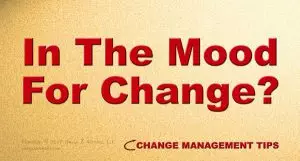Setting The Mood For Change As A Change Management Tactic
An owner of a top-flight commercial painting company once said to me, “Mike, prepping the surface is 90% of the paint job.” Setting the mood for change is prepping. Many companies don’t do this. They waste time.
What It Looks Like When The Mood Isn’t Set
For instance, before announcing any change, companies come up with what the change should be. They then plan for it. The plan has ways to communicate the change, ways to sell it.
Typically, this means the plan has a vision and ideas. It comes up with pros and cons. It answers “what’s in it for me.” All of these seek to breach the hard work of moving an organization’s culture to change. In effect though, that’s just slapping new paint over old. Cleaning, scraping and sanding don’t exist. In the end, change fails. The culture trumps it.

Change without setting the mood for change won’t change anything.
Setting The Mood With The Velten Mood Induction (MI)
The 40-year-old Velten Mood Induction forms the basis for why setting the mood for change works. For instance, in positive thinking reading or saying positive things puts one in a positive mood. Positive moods yield positive thoughts. It’s MI in its simplest form.
Over time MI came to include other moods. Today, researchers use it to see how our thoughts and behaviors change with moods. For instance, those reading violent things tend to then have aggressive moods.
In everyday life, we experience MI from movies, videos and music. Happy ones make leave us feeling happy. Sad ones sad and so forth. That’s how horror movies give nightmares. Politicians use MI to prep a nation for major events and issues such as war, tax reform and healthcare before any plan comes forth.
MI works at work too. It can put people in a more goal-oriented mood simply by talking about goals, outcomes and results. It can establish a more cooperative, collaborative culture by mentioning teamwork more than “what’s in it for me.”
Setting The Mood For Change
Therefore, companies can use the time before announcing change by setting the mood for change. It doesn’t need to be specific. It could be as simple as “recent events and results are having us look at some changes for next year.”
Yes, in the past, firms avoided such vagueness as it can instill uncertainty and fears. One is losing one’s job. Yet, a firm can minimize this through follow up, honesty and directness. For example, if an employee asks, “What changes are going to happen?” The manager could respond, “No one has decided anything yet. What changes do you think we need? What should we avoid?”
More importantly, these interactions sort out ideas, concerns, opportunities and obstacles for change. This can only make the final change management plan better.
- Change Management – Tactic #1: Pick the Right Moment
- Change Management – Tactic #2: Strengthen Relationships
- Change Management – Tactic #3: Break Into Small, Simple Steps
- Change Management – Tactic #4: Repetitiveness
- Change Management – Tactic #5: Request Demonstration
- Time Management Of Employees During Change Management
- Setting The Mood For Change As A Change Management Tactic
- Change Management – Tactic #8: Management by Walking Around
- How to Succeed at Culture Change Management


